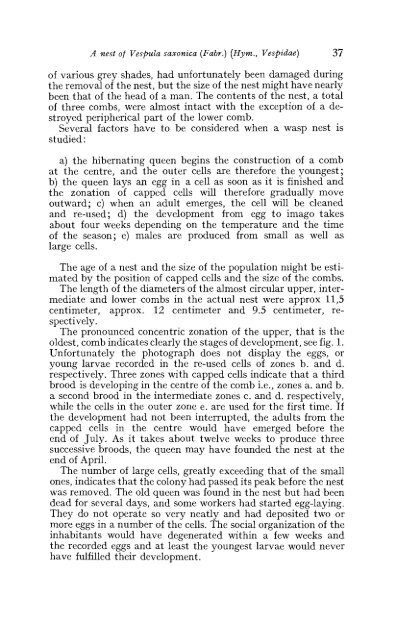NORSK ENTOMOLOGISK TIDSSKRIFT - Norsk entomologisk forening
NORSK ENTOMOLOGISK TIDSSKRIFT - Norsk entomologisk forening
NORSK ENTOMOLOGISK TIDSSKRIFT - Norsk entomologisk forening
Create successful ePaper yourself
Turn your PDF publications into a flip-book with our unique Google optimized e-Paper software.
A nest of Vespula saxonica (Eabr.) (Hym., Vespidae) 37<br />
of various grey shades, had unfortunately been damaged during<br />
the removal of the nest, but the size of the nest might have nearly<br />
been that of the head of a man. The contents of the nest, a total<br />
of three combs, were almost intact with the exception of a destroyed<br />
peripherical part of the lower comb.<br />
Several factors have to be considered when a wasp nest is<br />
studied :<br />
a) the hibernating queen begins the construction of a comb<br />
at the centre, and the outer cells are therefore the youngest;<br />
bj the queen lays an egg in a cell as soon as it is finished and<br />
the zonation of capped cells will therefore gradually move<br />
outward; c) when an adult emerges, the cell will be cleaned<br />
and re-used; d) the development from egg to imago takes<br />
about four weeks depending on the temperature and the time<br />
of the season; e) males are produced from small as well as<br />
large cells.<br />
The age of a nest and the size of the population might be estimated<br />
by the position of capped cells and the size of the combs.<br />
The length of the diameters of the almost circular upper, intermediate<br />
and lower combs in the actual nest were approx 11,5<br />
centimeter, approx. 12 centimeter and 9.5 centimeter, respectively.<br />
The pronounced concentric zonation of the upper, that is the<br />
oldest, comb indicates clearly the stages of development, see fig. 1.<br />
Unfortunately the photograph does not display the eggs, or<br />
young larvae recorded in the re-used cells of zones b. and d.<br />
respectively. Three zones with capped cells indicate that a third<br />
brood is developing in the centre of the comb i.e., zones a. and b.<br />
a second brood in the intermediate zones c. and d. respectively,<br />
while the cells in the outer zone e. are used for the first time. If<br />
the development had not been interrupted, the adults from the<br />
capped cells in the centre would have emerged before the<br />
end of July. As it takes about twelve weeks to produce three<br />
successive broods, the queen may have founded the nest at the<br />
end of April.<br />
The number of large cells, greatly exceeding that of the small<br />
ones, indicates that the colony had passed its peak before the nest<br />
was removed. The old queen was found in the nest but had been<br />
dead for several days, and some workers had started egg-laying.<br />
They do not operate so very neatly and had deposited two or<br />
more eggs in a number of the cells. The social organization of the<br />
inhabitants would have degenerated within a few weeks and<br />
the recorded eggs and at least the youngest larvae would never<br />
have fulfilled their development.

















